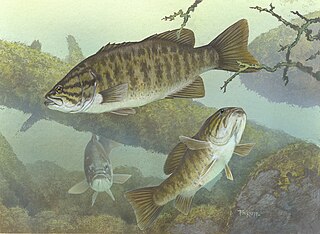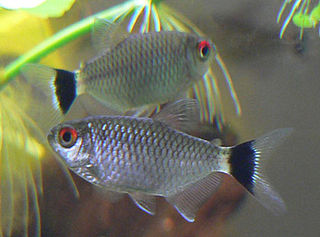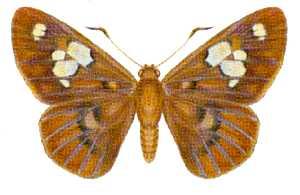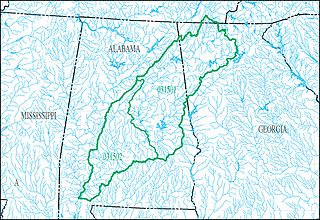
Micropterus is a genus of North American freshwater fish collectively known as the black bass, belonging to the sunfish family Centrarchidae of order Perciformes. They are sometimes erroneously called "black trout", but the name trout more correctly refers to certain members of the salmonid family.

The redeye bass, redeye, or Coosa bass is a species of freshwater fish in the sunfish family (Centrarchidae) native to the Coosa River system of Georgia, Alabama. The waters it is normally found in are cool streams and rivers in the foothills of mountains.

The shoal bass is a species of freshwater fish in the sunfish family (Centrarchidae) of order Perciformes. One of the black basses, it is native to waters in Florida and Georgia. It is also occasionally found in rivers and streams of East Alabama where it has been declared an endangered species and cannot legally be kept if caught by fishermen. Of typical size for a black bass, M. cataractae reaches a maximum recorded length of 24 inches (61 cm) and a maximum published weight of 8 pounds, 12 ounces.

The rock bass, also known as the rock perch, goggle-eye, red eye, and black perch, is a freshwater fish native to east-central North America. This red-eyed fish is a species of freshwater fish in the sunfish family (Centrarchidae) of order Perciformes and can be distinguished from other similar species by the six spines in the anal fin.

The General Dynamics FIM-43 Redeye is a man-portable surface-to-air missile system. It uses passive infrared homing to track its target. Production began in 1962 and – in anticipation of the Redeye II, which later became the FIM-92 Stinger – ended in the early 1970s after about 85,000 rounds had been built. The Redeye was withdrawn gradually between 1982 and 1995 as the Stinger was deployed, though it remained in service with various armed forces of the world until quite recently, being supplied via the Foreign Military Sales program. It was initially banned from being sold overseas, to avoid missiles falling into the hands of terrorist organizations. However, after the export ban was lifted, the weapon was never actually used by terrorists against civil aircraft, in contrast with other MANPADS. While the Redeye and 9K32 Strela-2 (SA-7) were similar, the missiles were not identical. Nonetheless, the CIA concluded that the Soviet SA-7 had benefited from the Redeye's development.

The small red-eyed damselfly is a member of the damselfly family Coenagrionidae. It is very similar to the red-eyed damselfly.

Coenagrionidae or are a family of damselflies, also known as pond damselfies, in the order Odonata and the suborder Zygoptera. The Zygoptera are the damselflies, which although less known than the dragonflies, are no less common. More than 1,300 species are in this family, making it the largest damselfly family. The family Coenagrionidae has six subfamilies: Agriocnemidinae, Argiinae, Coenagrioninae, Ischnurinae, Leptobasinae, and Pseudagrioninae.

Paul "Redeye" Chaloner is a British former esports broadcaster.

The redeye tetra, is a species of tetra from the São Francisco, upper Paraná, Paraguay and Uruguay river basins in eastern and central South America. This freshwater fish is commonly kept in aquariums and bred in large numbers at commercial facilities in Eastern Europe and Asia. The redeye tetra is one of the more popular aquarium fish due to their schooling capability.

Redeye Distribution is an American independent record label based in Hillsborough, North Carolina, United States. It was founded in 1996 by Tor Hansen, Kim Hansen, Glenn Dicker. The label focuses on independent music.

Psaltoda moerens, commonly known as the redeye, is an Australian species of cicada. It is distributed through the south-east of Australia, from southern Queensland to South Australia, as well as Tasmania. Populations can vary greatly between years; one year they may be present in large numbers and the next they may be entirely absent. They feed primarily on eucalyptus but also on Angophora trees. As they feed on tree sap they expel small droplets of clear waste fluid. When numbers are high, this can form a constant stream.

The redeye gaper, Chaunax stigmaeus, is a sedentary species of anglerfish in the family Chaunacidae. It is native to deep waters in the western North Atlantic from the Georges Bank off New England southward to the Blake Plateau off South Carolina. The species is found on the outer continental shelf and upper continental slope at a depth of 90–730 m and among dense beds of dead coral rubble, their preferred habitat. The original type specimen was caught in a trawl off Atlantic City on March 1, 1946, and donated to the Academy of Natural Sciences by Carroll B. Atkinson. The name stigmaeus means "speckled" in Greek. This species is a member of the C. pictus species complex.

Chaetocneme denitza, commonly known as the rare red-eye or ornate dusk-flat, is a species of butterfly in the skipper family Hesperiidae. It is endemic to Australia.

Gangara is an Indomalayan genus of grass skippers in the family Hesperiidae.

The goblet-marked damselfly is a medium-sized blue-and-black damselfly in the pond damselfly family (Coenagrionidae). It's a fairly common species in the South and West of Europe but is not found in the British Isles, Scandinavia and Eastern Europe. Erythromma lindenii was previously known as Coenagrion lindenii and Cercion lindenii. The goblet-marked damselfly is also known as the blue-eye. It's an easily recognized species, with its wide antehumeral stripes, narrow postocular spots, the male's very bright-blue eyes. He has very long and curved appendages, and the spear-shaped marks on S3-S6 of his abdomen.

The redeye barb or Beira barb, is a widespread African species of freshwater cyprinid fish which is found from Uganda south to the Limpopo River and Incomati River systems in South Africa.

Chaetocneme beata, also known as the common red-eye, eastern dull-flat or eastern dusk-flat, is a species of butterfly in the family Hesperiidae. It is found in Australia on the edges of the upland rainforest along the coast of Queensland and New South Wales.
Synanthedon erythromma is a moth of the family Sesiidae. It is known from Kenya.

The Alabama-Coosa-Tallapoosa River Basin is a drainage basin (watershed) in the Southeastern United States. The basin is located mainly in eastern Alabama, but also goes includes a small part of Georgia. This area is classified as a sub-region by the USGS hydrological code system.

Englemere Pond is a 26.1-hectare (64-acre) biological Site of Special Scientific Interest on the southern outskirts of North Ascot in Berkshire. The site is also a Local Nature Reserve. It is owned by the Crown Estate and managed by Bracknell Forest Borough Council.



















